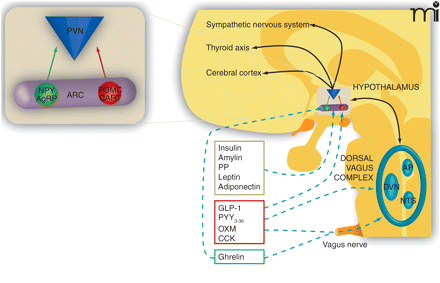
- Institution: Stanford Univ Med Ctr Lane Med Lib/Periodical Dept/Rm L109
- Sign In as Member / Individual
The Obesity Epidemic: Pharmacological Challenges

Integration of peripheral signals and central neuronal mechanisms in energy homeostasis and body weight. The hypothalamus and the dorsal vagal complex in the brainstem are central to the regulation of appetite. Hypothalamic circuits that control appetite are schematized in the inset (ARC, arcuate nucleus; PVN, paraventricular nucleus; NPY, neuropeptide Y; AgRP, Agouti related peptide; POMC, pro-opiomelanocortin; CART, cocaine and amphetamine regulated transcript). NPY- and AgRP-expressing neurons stimulate appetite (i.e., are orexigenic; green color); POMC- and CART-expressing neurons counterbalance this by reducing appetite (i.e., are anorexigenic; red color). The dorsal vagal complex comprises three nuclei: the area postrema (AP), the dorsal vagal nucleus (DVN), and the nucleus tractus solitarius (NTS). Peripheral signals are shown in boxes at the left (PP, pancreatic polypeptide; PYY3-36, peptide YY3-36; OXM, oxyntomodulin; CCK, cholecystokinin). The dashed arrows indicate their probable sites of action on the central mechanisms.


